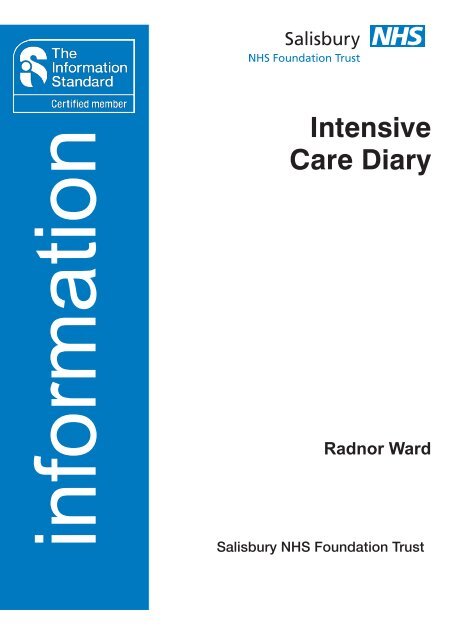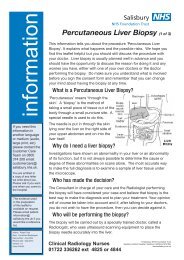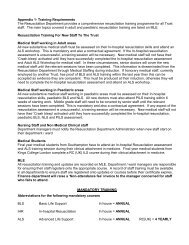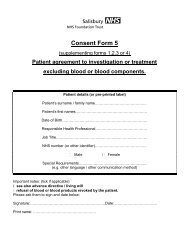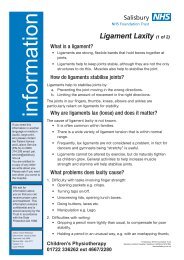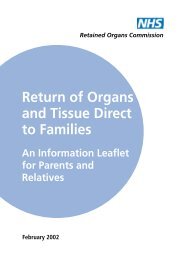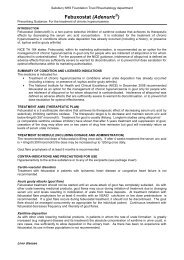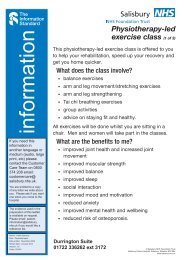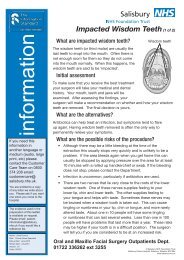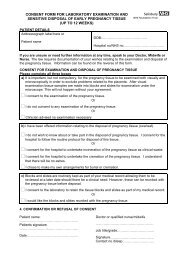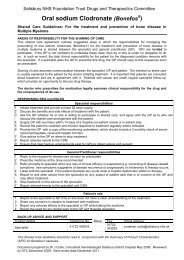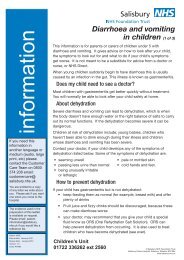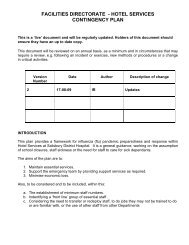Patient Diary - ICID - Salisbury NHS Foundation Trust
Patient Diary - ICID - Salisbury NHS Foundation Trust
Patient Diary - ICID - Salisbury NHS Foundation Trust
You also want an ePaper? Increase the reach of your titles
YUMPU automatically turns print PDFs into web optimized ePapers that Google loves.
information<br />
Intensive<br />
Care <strong>Diary</strong><br />
Radnor Ward<br />
<strong>Salisbury</strong> <strong>NHS</strong> <strong>Foundation</strong> <strong>Trust</strong>
Contents<br />
The purpose of your diary 3<br />
Admission Day - What happened? Why am I here? 4<br />
Visitor’s Blog / World / Local News 5<br />
Today’s news 6<br />
Visitor’s Blog / World / Local News 7<br />
Today’s news 8<br />
Visitor’s Blog / World / Local News 9<br />
Today’s news 10<br />
Visitors’ Blog / World / Local News 11<br />
Today’s news 12<br />
Visitors’ Blog / World / Local News 13<br />
Today’s news 14<br />
Visitors’ Blog / World / Local News 15<br />
Glossary 16<br />
Intubation 16<br />
Tracheostomy (also known as a ‘trache’) 16<br />
BiPAP & CPAP 17<br />
Arterial Line (ART line) 17<br />
Central Line or Central Venous Line (CVC or CVP) 17<br />
Nasogastric Tube (NG) 18<br />
Haemofiltration 18<br />
Calf/Foot Pumps 19<br />
Syringe Drivers 19<br />
2
The purpose of your diary<br />
• <strong>Patient</strong> diaries are a way of helping patients to<br />
understand what has happened to them whilst in the<br />
Intensive Care Unit (ICU).<br />
• They can help you come to terms with strange<br />
memories, such as hallucinations and nightmares,<br />
which can cause psychological problems after a<br />
serious illness.<br />
• Studies have shown that keeping a diary that includes<br />
photographs helps a patient to understand what has<br />
happened to them.<br />
• <strong>Patient</strong>s can be frustrated by their slow progress<br />
and cannot appreciate just how ill they were. By<br />
reading the diary and seeing themselves attached to<br />
equipment, such as a ventilator, may help patients to<br />
make sense of their ICU stay.<br />
• The diary may also help relatives and friends. It can<br />
offer a focus and somewhere to express their feelings.<br />
Writing in your diary can help your family feel they are<br />
contributing to your recovery and rehabilitation, that<br />
they are ‘doing’ something for you.<br />
• At the back of the diary is a glossary that you and<br />
your relatives may find helpful.<br />
3
Intensive Care <strong>Diary</strong><br />
Admission Day - What happened? Why am I here?<br />
photograph<br />
4
Visitor’s Blog / World / Local News<br />
5
Today’s news<br />
Day:<br />
Date:<br />
Day Nurse:<br />
Night Nurse:<br />
6
Visitor’s Blog / World / Local News<br />
7
Today’s news<br />
Day:<br />
Date:<br />
Day Nurse:<br />
Night Nurse:<br />
photograph<br />
8
Visitor’s Blog / World / Local News<br />
9
Today’s news<br />
Day:<br />
Date:<br />
Day Nurse:<br />
Night Nurse:<br />
10
Visitors’ Blog / World / Local News<br />
11
Today’s news<br />
Day:<br />
Date:<br />
Day Nurse:<br />
Night Nurse:<br />
12
Visitors’ Blog / World / Local News<br />
13
Today’s news<br />
Day:<br />
Date:<br />
Day Nurse:<br />
Night Nurse:<br />
14
Visitors’ Blog / World / Local News<br />
15
16<br />
Glossary<br />
Intubation<br />
Intubation is a common procedure for Intensive Care<br />
patients. It can be done for several reasons, the most<br />
common being to help a patient with their breathing whilst<br />
they are critically ill.<br />
It is done by inserting a flexible plastic tube (known as an<br />
endotracheal tube)<br />
Endotracheal tube<br />
through the patient’s<br />
Cuff inflation tube<br />
mouth down into the<br />
large airway going<br />
from the mouth to the<br />
lungs. This is then<br />
attached to a machine<br />
called a ventilator,<br />
which either helps<br />
the patient breath, or takes over breathing for the patient.<br />
<strong>Patient</strong>s are either unconscious when this is done or are<br />
anaesthetised.<br />
The tube makes sure that the patient’s airway remains clear<br />
and gives access for artificial respiration. Suction down the<br />
tube clears a build-up of lung secretions.<br />
Tracheostomy (also known as a ‘trache’)<br />
A tracheostomy is a surgically created<br />
opening in the windpipe (trachea). It is<br />
kept open with a hollow tube called a<br />
tracheostomy tube.
It usually replaces the endotracheal tube as it is more<br />
comfortable and safer for patients who need ventilation or<br />
help in keeping their airway open they are recovering. It can<br />
also be used in an emergency to allow ventilation when the<br />
upper airway is blocked.<br />
BiPAP & CPAP<br />
BiPAP = bi-phasic positive airway<br />
pressure<br />
CPAP = continuous positive airway<br />
pressure<br />
Both CPAP and BiPAP are used to<br />
help breathing.<br />
The device forces air at high pressure in to the airway to<br />
overcome a blockage and to stimulate normal breathing.<br />
Arterial Line (ART line)<br />
Most Intensive Care patients will have an arterial line, which<br />
is usually placed in the wrist. The line is connected to an<br />
observation monitor and lets the nurse<br />
measure the patients blood pressure<br />
and heart rate continually. It is also<br />
used to take blood samples.<br />
Central Line or Central Venous Line (CVC or CVP)<br />
These are quite common for most patients to have. They are<br />
usually placed in the neck or groin and fed through to a large<br />
17
vein that returns blood to the heart.<br />
Central lines have a number of different<br />
uses:<br />
18<br />
• To infuse strong solutions which<br />
could cause damage to smaller<br />
veins (such as the ones in the<br />
arms).<br />
• Monitoring, such as measuring pressures in the heart.<br />
• To give drugs.<br />
Having a CVC or CVP reduces the number of separate<br />
injections and drips a patients needs. Central lines can be<br />
short term or long term.<br />
Nasogastric Tube (NG)<br />
This is a thin flexible tube that<br />
is passed through one of the<br />
patient’s nostrils and down<br />
the gullet into the stomach. It<br />
has two main uses. Firstly it<br />
removes the contents of the<br />
stomach, such as air or fluid,<br />
and secondly to give liquid<br />
nutrients directly into the<br />
stomach when the patient is<br />
unable to eat normally.<br />
Haemofiltration<br />
Haemofiltration is a therapy used to replace the function of<br />
the kidneys if they go into renal failure (where the kidneys
produce none, or very<br />
little urine, which means<br />
the body is not filtering<br />
fluid efficiently).<br />
Haemofiltration is done<br />
by passing the patient’s<br />
blood through a fine<br />
tube line into a machine<br />
that filters out the waste<br />
products and water. It then adds replacement fluid before<br />
returning the blood into the body via a central line.<br />
Calf/Foot Pumps<br />
These are cuffs that are put<br />
round the lower leg of the<br />
patient and secured with<br />
Velcro. They are attached<br />
to a pump that gently and<br />
regularly inflates the cuff.<br />
They are used to prevent blood clots forming (deep vein<br />
thrombosis).<br />
Syringe Drivers<br />
These are used to deliver<br />
regular set amounts of<br />
medication at set times.<br />
You will often see several<br />
of these machines around<br />
an ITU bed space.<br />
19
Author: Jacqueline Weaver Jocelyn Shepley<br />
Role: Intensive Care Staff<br />
Date written: March 2012<br />
Review date: April 2014<br />
Version: 1.0<br />
Code: PI0933<br />
If you need this information in another language or medium<br />
(audio, large print, etc) please contact the Customer Care<br />
Team on 0800 374208 email: customercare@salisbury.nhs.<br />
uk.<br />
You are entitled to a copy of any letter we write about you. Please ask if you want<br />
one when you come to the hospital.<br />
The evidence used in the preparation of this leaflet is available on request. Please<br />
email patient.information@salisbury.nhs.uk if you would like a reference list.<br />
© <strong>Salisbury</strong> <strong>NHS</strong> <strong>Foundation</strong> <strong>Trust</strong><br />
<strong>Salisbury</strong> District Hospital, <strong>Salisbury</strong>, Wiltshire SP2 8BJ<br />
www.salisbury.nhs.uk


